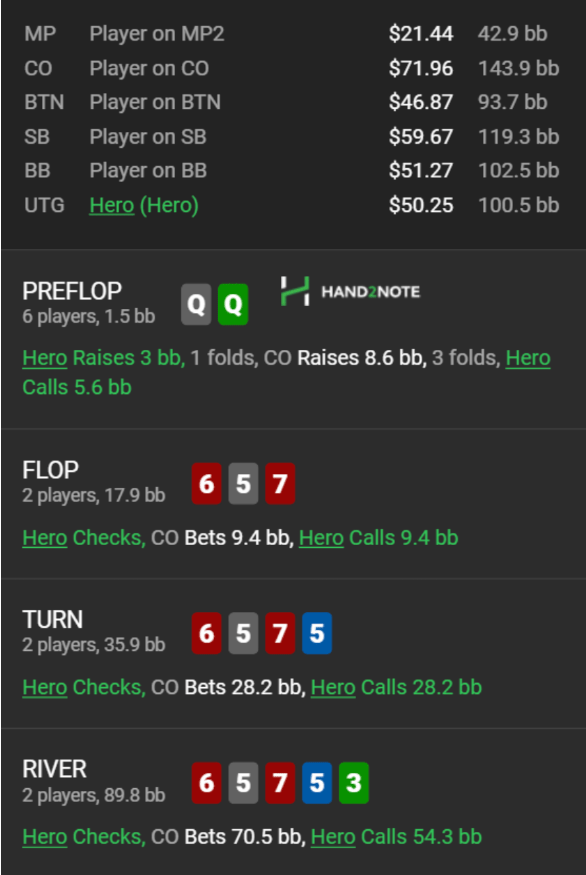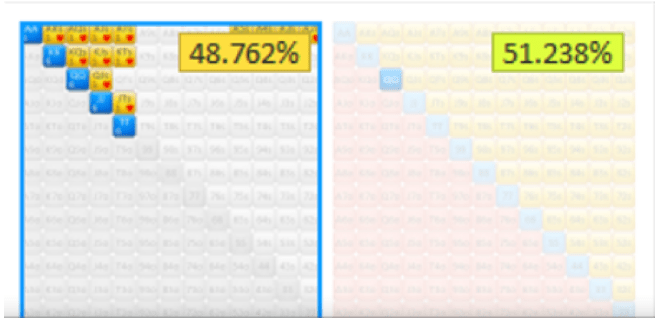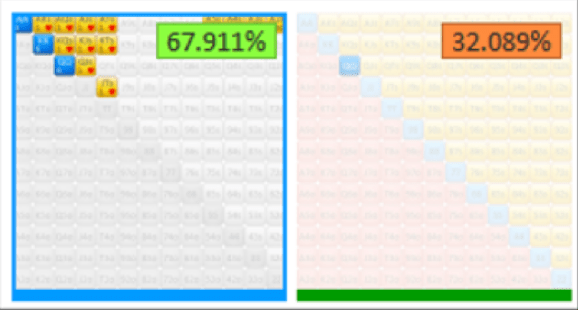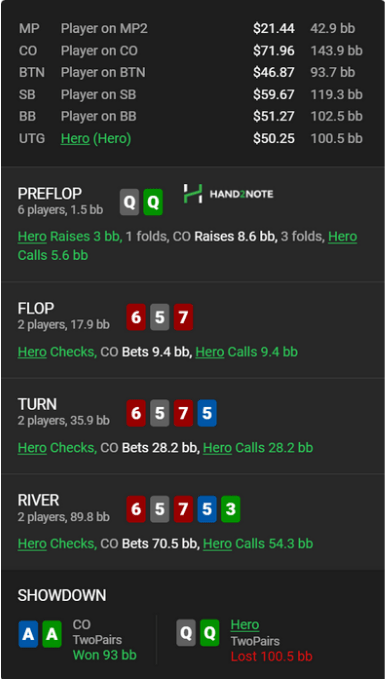We continue to help low-stakes regulars analyze hands correctly. Vladimir Alkohero, who plays fast poker at PokerOK, agreed to test his skills and provided an analysis of the hand at NL50.

The showdown and the outcome of the surrender can be found at the end of the article.
Player Analysis
Preflop
Given positions, I prefer to just call rather than 4-bet.
Flop
Seems to be more suitable for the caller. I can have 77 and 66, and sometimes 89s, but my opponent does not. Now I think that there was an option to raise the flop, but then it is not clear what to do in case of another raise.
Turn
The opponent continues to bet. For value, he has AA and KK. Sets and straights should not be. In this case, there can be AK, AQ, and a bunch of overcards. There might also be JJs. I do not like the sizing of both the flop and the turn, as they are interconnected. But I can't fold, and I'm afraid to raise.
River
Opponent didn't get an overcard. AA and KK continue to barrel. I understand that somewhere I have already done something wrong, but when I got to the river, I could not throw it away.
Questions – where to fold, where to raise, where to call? What was the best way to play the hand?
Trainer Analysis
From the editors – Ivan Megaman, who will have to answer these questions, we found thanks to the "Training" section.
What separates the amateur from the pro? An amateur simply tries to play in position more often, while a professional seeks to put his opponent in a tough position. In fact, often there is no need to try – most players themselves adopt such a pose at the table.
I was asked to analyze a hand of an "average" NL25-50 fast poker regular. First, a few words about how you don't beat fast tables. In theory, of course, they fight, but only if a person has a skill two heads higher than the field. That is, to beat rush&cash NL25, you need to be a good fifty-fast poker reg or even close to NL100 in terms of level.
A logical question – if you already play at this level, then why roll lower? :) But this is all philosophy, and here it's about cards, so let's go.
So we have a hand + thoughts on the game of the person who played it.
We have no information about the opponent, so we will analyze it in a vacuum. What to do when we play against the unknown? There is a golden rule – against the unknown, we play as if it is an average competent player, that is, one who knows as much or more than you, until he has proven otherwise.
In this hand, we play out of position.

Given positions, I prefer to just call rather than 4-bet.
Hero should pay attention to sizing – Villain 3-bets 8.6 big blinds, nearly reaching the standard nine big blinds. Most likely, he does not want a fold. But that's not for sure :) But it's for sure that "taking into account the positions" Hero will have big problems with the realization of equity postflop. Just “taking into account the position” and the tendencies of the field, it’s easier to play from a 4-bet here, since this will allow you to determine the opponent’s range for less money.
The average low-stakes reg is unnecessarily passive preflop even in late position. Against UTG, in practice, there will be no indicators close to the TRP, everyone plays “make a combination”, although coming up with bluffs in the opponents’ range remains a favorite pastime for NL25-50 regs.

“Seems to be more suitable for the caller. I can have 77 and 66, and sometimes 89s, but my opponent does not.”
That's right, the flop fits UTG's 3-bet calling range, pocket pairs will be enough there – as many as 33 combos and a suited broadway, plus, according to Hero, connectors. It turns out about 40 combos. But the flop does not fit "more", but just fits, and if we play against "average-competent", he should also understand this.
Now I think that there was an option to raise the flop, but then it is not clear what to do in case of another raise.
To get started, you just need to open the Flopzilla and see your equity against the range with which the opponent will continue in the event of this raise. There are two options here.
First, if our opponent is unable to throw TT/JJ, then we flip a coin.

Second, if Villain folds TT/JJ it's even worse.

But let's be honest – no one here will ever fold their JJ;) Accordingly, it was still possible to flip a coin on the flop, although everything should have been decided preflop…

The opponent continues to bet. For value, he has AA and KK. Sets and straights should not be. In this case, there can be AK, AQ, and a bunch of overcards. There might also be JJs. I do not like the sizing of both the flop and the turn, as they are interconnected. But I can't fold, and I'm afraid to raise.
Yes, but in addition to AA and KK, he also has 99-QQ. A total of 31 combinations of value. AKo and AQo check because the turn is a blank and the fold equity isn't enough. There will be value bets and natural bluffs.
We still hit a lot on the turn. When playing out of position, unfortunately, it is difficult to realize equity. Therefore, we have to decide here and now whether we continue or not, and we continue only through a check-push.
If we choose to call, we give equity to our opponent's natural bluffs. The most you can dream of in this situation is to check the river and see a check behind. When a scary card comes out, hitting possible bluffs, we cannot call. But even when the blank comes, we cannot press the call either.

Opponent didn't get an overcard. AA and KK continue to barrel. I understand that somewhere I have already done something wrong, but when I got to the river, I could not throw it away.
Questions – where to fold, where to raise, where to call? What was the best way to play the hand?
Given the unlikelihood of checking into an under bluff, the river is a simple fold. Hero should remember what he would do in similar situations when he also bets the nuts on the river, checks medium value (because he does not know where he is at), and under-bluffs because he is scared. And no one will fold a pair on the river when the draw didn't get there.
I will share another rule: when you are bet on the river, divide your opponent's range into two parts – a bluff and a value. Count the combinations, and figure out which has more. And then divide the value into two parts – what we beat and what beats us. If we lose more than we win, it's a fold.
To be an NL25-50 top reg you only need three skills:
1. Defend the blinds well
2. Collect your value
3. Don't pay when they charge you
Hand result
Spoiler:












